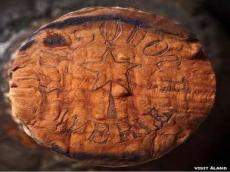Today.Az » Weird / Interesting » Champagne from 1840s shipwreck analysed
21 April 2015 [12:30] - Today.Az
 Bottles of champagne salvaged from a 170-year-old shipwreck have been tested in the lab by scientists seeking clues about historic winemaking methods.
Bottles of champagne salvaged from a 170-year-old shipwreck have been tested in the lab by scientists seeking clues about historic winemaking methods.
Among the results were very high levels of sugar - higher than most modern dessert wine - and traces of arsenic.
168 bottles were found 50m beneath the Baltic Sea in July 2010, several of them unusually well-preserved due to the stable, cold and dark conditions.
Some of them sold at auction in 2011 for tens of thousands of euros.
The new study, published in the journal PNAS, reports "chemical and sensory analysis" of the historic liquid. It was led by Prof Philippe Jeandet, from the University of Reims in Champagne-Ardenne, France.
Prof Jeandet and his colleagues used various types of chemical analysis to compare the make-up of three bottles from the shipwreck, made by Veuve Cliquot, with bottles made recently by the same champagne house.
He told the BBC he only got to taste 0.1ml of the wine, as part of working with experts and winemakers at Veuve Cliquot to conduct the analysis.
"It was impossible to smell," Prof Jeandet said, because of the tiny quantity. "But it was fabulous - just tasting 100 microlitres."
He remembers flavours of tobacco and leather, he said. "The taste remained for two or three hours."
As part of their analysis, Prof Jeandet's team found the wine's composition was surprisingly similar to the modern samples, with some notable differences.
To begin with, there weren't many bubbles left. "The CO2 remaining was less than 2g per litre. If you compare to normal champagne - the CO2 in a bottle is around 10-11g per litre," Prof Jeandet said.
This was probably because the gas gradually escaped through the corks, he added.
Apart from that loss of fizz, the conditions under the sea - a stable temperature of 2-4C, relatively low salinity, low levels of light and high pressure - served the wine remarkably well.
"What was most surprising... was to see that the aromas and chemical features were preserved during the time the wine spent at the bottom of the sea," Prof Jeandet said.
Different tastes
Andrew Waterhouse, an oenologist at the University of California Davis, told the BBC the research was "very interesting" - making particular mention of the high sugar content the researchers reported.
"This is a type of wine we still drink today. So it's not an ancient relic, it's part of our current history - we do drink champagne these days.
"But this champagne is very different, especially with regard to sugar level."
At more than 14%, the sugar content was "astonishingly high", Prof Waterhouse said - higher than most dessert wines today. But it appears to have been sold, much as it is today, to be drunk at receptions and celebrations.
"It points out how different the tastes were back then."
Consumers in the UK and the US, particularly, have driven the sugar content down over the years. Even in the 19th Century, Prof Jeandet said, tastes on the continent were much sweeter - and these Baltic bottles were probably typical.
Prof Waterhouse also pointed out the traces of arsenic the researchers spotted, which may indicate the use of arsenic salts to control pests in the vineyard, as well as surprisingly high levels of lead and iron.
These metals probably came from the barrels used before the wine was bottled, he added. These may have had iron fittings and brass valves, containing lead.
/By BBC/
|
|